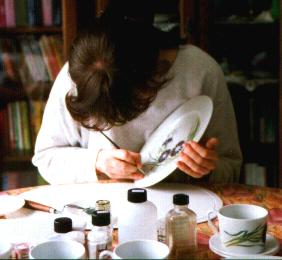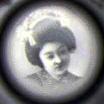| Małgorzata Wrochna |
Hand-painted porcelain

The classic European technique of overglaze painting
In this technique, paints and gildings are applied on glazed porcelain, which must then be fired at approx. 750oC. During firing, the pigments melt into the enamel, the decoration becomes durable, resistant to abrasion and light. With a fork and knife, we can neither scratch it nor damage in any way.
Gilding

Gold - so-called matt gold - suspended in a special solvent, is applied with a brush or pen and then after firing it is grounded. The gilding obtained in this way is in fact a thin layer of pure gold, containing no admixtures. Its gloss depends on the method of grinding. Grinding with a glass brush or sand gives the gloss like the one of jewelery.

Artistic grinding with agate allows to make precise boundaries of shiny surfaces from matt - left without grinding.
Motifs obtained in this way are characterized by a beautiful, noble sheen of pure gold, very different from the gloss of the "mirror" decorated porcelain in factories using the so-called shiny gold. However, the agate grinding technique is very difficult. It requires an extremely precise hand. That's why very few artists in the world knows and applies it in practice.
Porcelaine


I like the most painting on Japanese porcelain, because it is more delicate and thinner than the best porcelain in Europe. I usually use porcelain "geisha girl " called so from a litophany with the head of a geisha visible to the light on the bottom of a cup.
|
I also like to paint on Polish porcelain. Simple and beautiful shape has, for example a set "Nora" produced by "Karolina" workshop. |